Yes, you can.
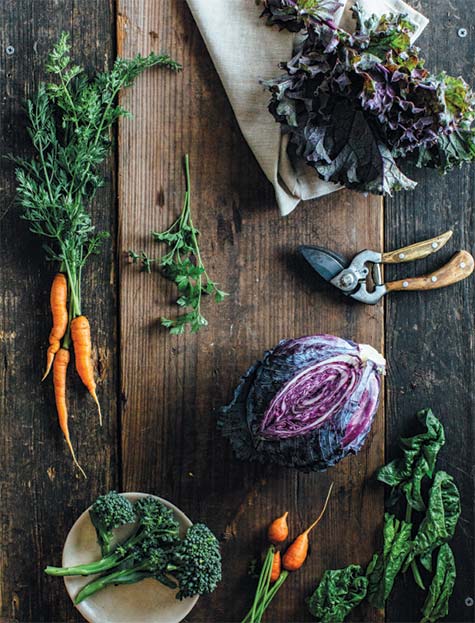 Winter’s garden bounty.
Winter’s garden bounty.
Photos by Kelsi Klembara and Marshall Hinsley
If you enjoy gardening in North Texas but hang up your tools for the winter, you’re missing out on a nearly hassle-free time to grow your own grub.
Unlike states north of the Red River, Texas has just two seasons when it comes to gardening: a hot one and a cool one. Too many people think only of the hot season. But as eating local has caught on in North Texas, more gardeners and farmers in the area are learning that with a little planning and few, simple techniques, they can produce nutrient-dense crops that flourish in our mild winters, producing a bounty not only for their own tables but for farmers market shoppers, too.
What’s more, cool season gardening isn’t about pushing summer crops to produce out of season. It’s an opportunity to grow broccoli, cauliflower and dark leafy greens that simply can’t stand up to warm-season pests and summertime heat—they need cool weather. Frost may kill tomatoes, squash and okra, but it actually improves the flavor and texture of winter crops.
“We typically grow and eat from our garden 365 days a year,” says Heather Rinaldi, owner of Texas Worm Ranch and a local gardener who sells her produce at Good Local Markets in East Dallas. “The hardiest crops, which bounce back from freezes, seem to be cilantro, kale and Swiss chard. We love Asian greens like tatsoi and bok choy—they will withstand a wide temperature range from warm days to cold nights and are very healthy and versatile, as they can be eaten raw or thrown into a stir-fry. We also love Brussels sprouts and broccoli.”
To these frost-proof recommendations, add lettuce, collard greens, carrots and beets, says Elizabeth Dry, founder and executive director of Dallas’ Promise of Peace Community Garden—a garden that doubles as both a source of food and a crop-growing classroom. “The rewards of growing garden goodness are so abundant that we keep it going year-round,” says Dry.
“Winter gardening has many great benefits,” says Rusty Allen, education and outreach coordinator for North Haven Gardens in Dallas. “Sunny, cool days with cooler nights mean beautifully rich, green spinach leaves will impart their nutrient profile fully. Many other greens, organically grown, are simply the best you’ve ever had, once you grow them yourself at home.”
The right winter crops can sustain mild chills indefinitely. Mustard and turnip greens become crispier, more tender and less bitter after a brush with winter weather. While summer crops turn into a heap of dead vegetable matter after even the mildest frost, broccoli and kale, along with the rest of the winter crops, grow right through a blanket of snow.
Most of these crops can be grown throughout the winter with no special accommodations. If an occasional freeze dips a little too far below their tolerance level—plunging below the mid-20s— some growth can succumb, but the plant will put out new leaves as soon as the weather warms back to normal.
Some gardeners keep their wintertime crops growing no matter how severe winter weather becomes by protecting them in one way or another. Siting a garden near a south-facing wall shields crops from extreme arctic blasts, and a lightweight frost blanket draped over veggies traps heat and gets them through a spell of unusually brisk temperatures.
“I group together plants that are the most frost-tender, so when the need to cover them with frost cloth comes, it is more efficiently done,” says Marie Tedei, owner of Eden’s Organic Garden Center and Eden’s Garden CSA Farm in Balch Springs.
Rinaldi has a multi-pronged approach to beating extreme weather. She’s built several hoop frames that go over her raised garden beds. When frost blanketing is wrapped over the frame, the crops are covered in what look like mini, 3-foot-tall covered wagons from pioneer days. “We also plant the more tender stuff at a more sheltered garden,” says Rinaldi.
“Just like in the extreme heat, we also put a little extra ground cover around the roots of the plants, such as pine needles,” adds Dry.
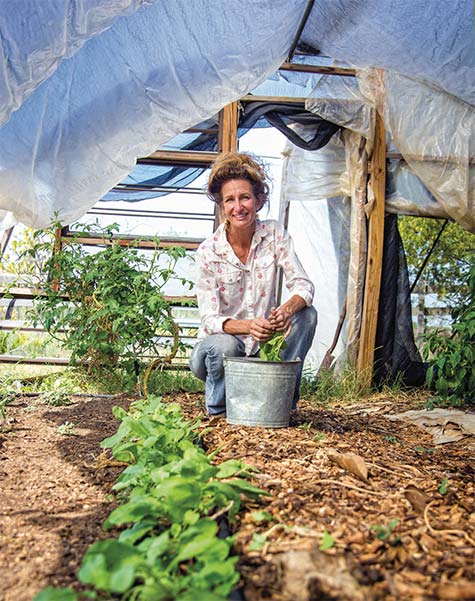 Marie Tedei gets an early start with winter plantings
Marie Tedei gets an early start with winter plantings
at her Eden’s Organic Garden Center and
Eden’s Garden CSA Farm in Balch Springs.
But for the bulk of a normal North Texas winter, cool season veggies do just fine growing out in the open air. Some winters even come and go with no need to cover a crop. It’s during these mild winters that gardeners enjoy a nonstop harvest.
“There is less pressure from insects during the winter,” says Tedei, “and I can work barefooted sometimes, because the fire ants aren’t as active. Plus of course, the hours are more flexible because you don’t have scorching heat to hide from in the afternoon. I think I get more done in the winter.”
Timing is also essential for successful wintertime gardening says Monica Solimani, who owns Edible Landscapes Dallas. Her company installs and maintains vegetable gardens throughout the Metroplex, including home gardens.
“I usually have two planting lists,” says Solimani. “Early fall veggies that should be planted by seed during the last week of August until the first week of October include radishes, carrots, beets, onions— pretty much anything underground, the root crops. … I wouldn’t plant these crops in November through December.
“The mid-fall veggies that I install by transplant beginning in last two weeks in September to the third week in October are lettuces, broccoli, cauliflower, Brussels sprouts, cabbage, kale…. If you’re getting a late start in November, I recommend artichokes, lettuces, spinach, kale, broccoli, cauliflower and Brussels sprouts.”
For members of the cabbage family, Solimani recommends building up a garden bed with plenty of nutrients, especially nitrogen. But not for lettuce. “Keep the heavy nitrogen fertilizers away from the lettuces,” she says. “I usually feed my lettuce plants a liquid fertilizer with low nitrogen and alternate it with liquid seaweed throughout the season. I fertilize my gardens twice a month.”
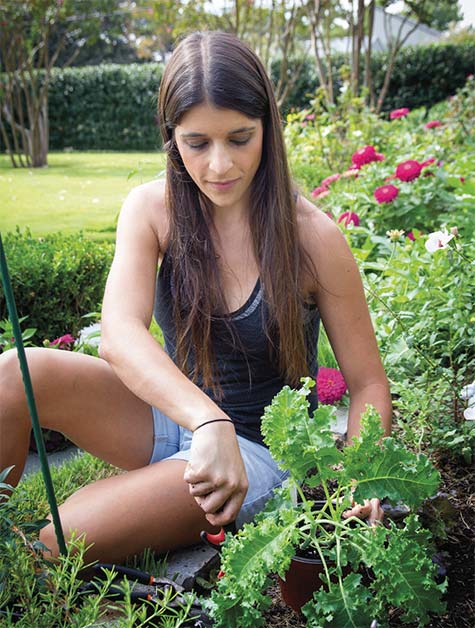 Monica Solimani, who owns Edible Landscapes Dallas, helps
Monica Solimani, who owns Edible Landscapes Dallas, helps
set up winter plantings for even very small home gardens.
Mustard and turnip greens become
crispier, more tender and less bitter
after a brush with winter weather.
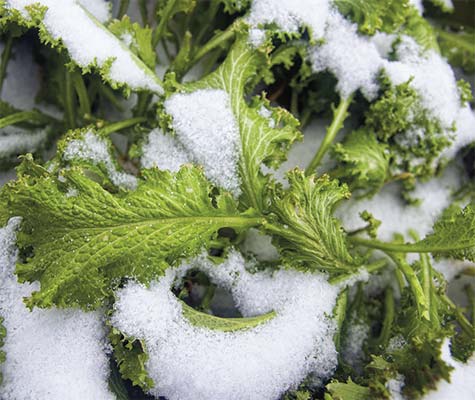 Mustard greens grow just fine with a dusting of snow.
Mustard greens grow just fine with a dusting of snow.
Although a winter garden needs much less supplemental watering, Solimani says to be sure to water plants thoroughly when a frost or freeze is in the weather forecast. “Plants that are hydrated are more likely to survive a freeze. Dry soil and freezing temperatures plus cold winds will result in plant casualties,” she says.
As more farmers and gardeners discover the North Texas advantage of growing a variety of crops year-round, their surplus has increasingly been finding its way to local restaurants and markets. Not everyone has the time or space to grow their own, but just as tasty and nutritious will be the locally sourced winter crops at the Dallas Farmers Market, says Chad Julka, farm coordinator for the market.
“Depending on weather and other factors, we are hoping for a great set of options,” Julka says. “Things that grow well here in Texas are leafy greens, root vegetables, and brassicas and citrus.” You’ll find them at other winter markets, too.
Julka says that although locally sourced winter produce is nothing new at the Dallas Farmers Market, more farmers have been showing interest in taking on winter crops. “Good Earth Organics and Grow It Forward are currently participating with direct sales at the market. Other growers will have either direct sales or have their products sold through farm representation.
“Products from potentially dozens of growers will participate in the beginning stages of a food hub, which is a distribution entity that assists small and medium-sized farms with wholesale markets and can also aggregate products from many smaller farms [to sell at the market],” Julka says. That means more opportunities for farmers and shoppers alike.
“I prefer wintertime gardening,” says Rinaldi. “There are fewer pests, and you can be so much more productive per square foot of space. I love providing meals I have cared for from seed to table, especially on holidays. Healthy lifestyles, good memories and family time together are all gifts from the garden.”
Cool season gardening isn’t about pushing
summer crops to produce out of season. . . .
Frost may kill tomatoes, squash and okra,
but it actually improves the flavor
and texture of winter crops.
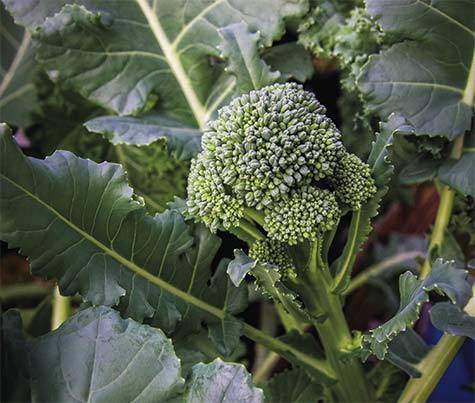 Broccoli is another cold weather vegetable that thrives in our region.
Broccoli is another cold weather vegetable that thrives in our region.
INDOOR ALTERNATIVE: GROW HERBS
If you want to tend a little garden of your own but don’t have the time or space to grow outdoors, try an indoor herb garden says Monica Solimani of Edible Landscapes Dallas.
Just a few pots of herbs growing in a bright sunny window can produce all the seasonings you need for a variety of dishes.
“I recommend oregano, thyme, mint, basil if you want to try it,” says Solimani. Fresh cilantro also grows well on a window sill and puts to shame its grocery store counterpart.
Your indoor herb garden can be as simple as a few small terracotta pots with a rich, organic potting soil as the growing medium. For ease in getting started, buy transplants.
Feeding them when you water with a liquid organic fertilizer and alternating with liquid seaweed is all it takes to keep them well nourished.
“On sunny days in the winter, I recommend placing your herbs outside for some fresh air,” says Solimani. “The key to growing herbs indoors is not to overwater them. Remember, they don’t dry out as fast as herbs planted in containers outside on a patio. If the soil is soaked and the foliage is a sick pale yellow, chances are you are overwatering them.”
MARSHALL HINSLEY is a writer and photographer who lives with his wife on a 40-acre farm south of Dallas. With a passion for growing sweet, vine-ripe specialty melons, he's also a sustainable farmer whose mission is to grow food crops in a way that improves the ecosystem and benefits wildlife as well.
-
Marshall HInsleyhttps://www.edibledfw.com/author/mhinsley/
-
Marshall HInsleyhttps://www.edibledfw.com/author/mhinsley/
-
Marshall HInsleyhttps://www.edibledfw.com/author/mhinsley/
-
Marshall HInsleyhttps://www.edibledfw.com/author/mhinsley/











